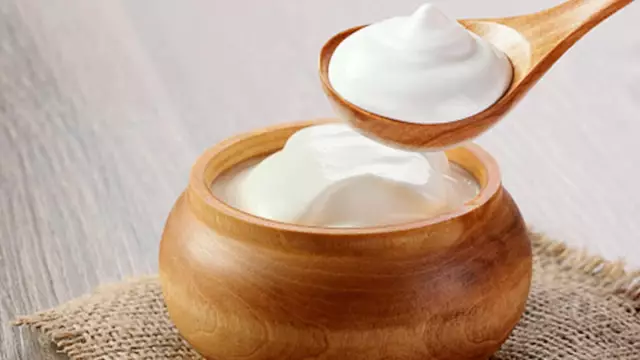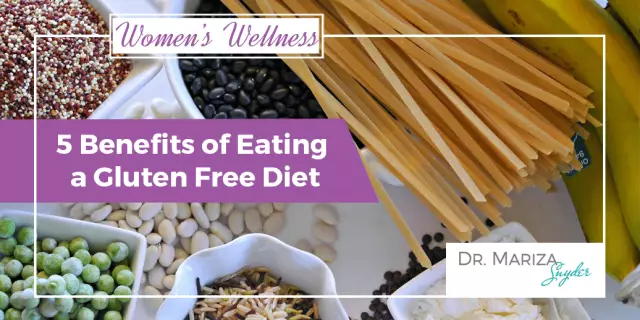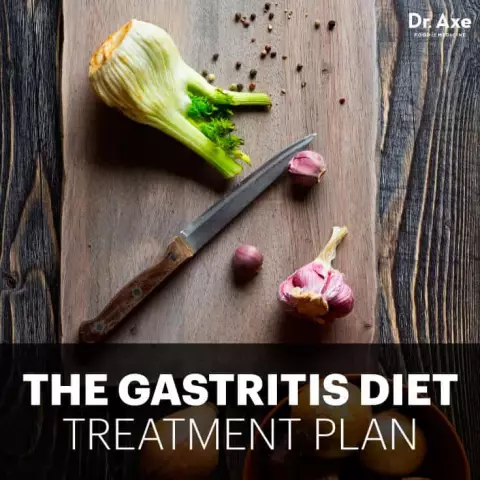- Author Rachel Wainwright [email protected].
- Public 2023-12-15 07:39.
- Last modified 2025-11-02 20:14.
Erosive gastritis
The content of the article:
- Causes and risk factors
- Forms of the disease
- Symptoms of erosive gastritis
- Diagnostics
- Treatment of erosive gastritis
- Possible complications and consequences
- Forecast
- Prevention
Erosive gastritis is an inflammation of the gastric mucosa with the formation of various sizes of erosions on its surface (ulcerations that do not penetrate into the deep layers of the gastric wall and heal without subsequent scarring). The depth of the erosive defect is the main difference between this disease and gastric ulcer, when not only the mucous membrane is damaged, but also the underlying tissues, muscle layers.

Picture of erosive gastritis
The main danger of erosive gastritis is the possible development of bleeding from the damaged mucous membrane. According to some reports, more than 20% of episodes of gastric bleeding are associated precisely with the presence of erosive gastritis.
Currently, the terminology adopted for the designation of pathology is being revised: more often the definitions "hemorrhagic gastropathy" or "hemorrhagic gastritis" and "papular gastropathy" are used to designate erosive gastritis.
When carrying out fibrogastroduodenoscopy for complaints of digestive disorders (heartburn, pain in the epigastric region, nausea, vomiting), erosion of the gastric mucosa is recorded in 25% of cases.
Erosive gastritis occurs equally often in men and women of different age groups. In children, pathology is detected much less often. A number of studies indicate a manifold increase in the incidence of erosive gastritis in recent years (some sources speak of a tenfold increase in the incidence), which is associated with an intense lifestyle, a high risk of exposure to stress factors, improper eating behavior and improved diagnostic techniques that make it possible to detect the disease even in the absence of active complaints.
Causes and risk factors
The main reason for the development of erosive gastritis in 60-80% of cases is considered to be infection with Helicobacter pylori microorganisms, although it is generally accepted that the disease is polyetiologic (for its formation, a combined effect of several causal factors is necessary).

The main cause of erosive gastritis is infection with Helicobacter pylori microorganisms
Isolated for the first time in 1981 by Warren and Marshall, the spiral-shaped bacterium equipped with flagella survives safely in the acidic environment of the stomach. Helicobacter pylori is able to move rapidly in the viscous mucus covering the walls of the organ. Under the influence of special enzymes that destroy local protective factors, it is introduced into the mucous membrane, colonizing it, and causes local inflammation with the formation of erosive defects. A feature of a microorganism is its ability to develop protective factors in relation to antibacterial drugs and immune antibodies.
Despite the fact that the infection with these bacteria, according to some researchers, reaches 70%, which makes Helicobacter pylori infection the most common in the world, in 2/3 of cases it is asymptomatic, without causing morphological changes in the gastric mucosa. This is due to powerful internal defense factors that compensate for the disease-causing effect.
In addition to infection with Helicobacter pylori, the causes of erosive gastritis can be:
- acute stressful situations or chronic psychoemotional overstrain, leading to disruption of innervation and, as a result, trophic processes in the gastric mucosa;
- systematic use of aggressive liquids (mainly alcoholic beverages);
- incorrect eating behavior (long periods of hunger, abuse of spicy, salty, fatty foods, smoking on an empty stomach and consumption of foods and drinks on an empty stomach that irritate its mucous membrane);
- taking gastrotropic drugs that have a damaging effect on the inner lining of the organ (non-steroidal anti-inflammatory drugs, salicylic acid derivatives, glucocorticosteroid hormones);
- stagnation in the system v. portae for liver pathologies;
- chronic diseases of the gastrointestinal tract;
- pressure on the mucous membrane of volumetric neoplasms localized in the submucosa;
- acute or chronic hypoxia (trauma, massive burns, severe heart or respiratory failure, coma);
- extensive surgical interventions (the production of hydrochloric acid, one of the factors of aggression, increases up to 4 times within 10 days after the operation);
- severe diabetic ketoacidosis;
- occupational hazards (salts of heavy metals, pesticides, vapors of paints and varnishes, aromatic hydrocarbons);
- throwing the contents of the duodenum into the stomach during digestion with the failure of the gastroduodenal sphincter.
Under the influence of pathogenic microorganisms and various pathological conditions, local defense mechanisms are weakened, the balance shifts towards the prevalence of factors of aggression (bile throwing into the stomach, excess production of pepsin and hydrochloric acid). As a result, metabolic processes suffer, the regeneration of the epithelium and the production of protective mucus deteriorate, local microcirculation disorders develop, which ultimately leads to the formation of superficial ulcerative defects and the development of erosive gastritis.
Forms of the disease
There are several forms of erosion:
- primary erosion - develop without connection with the previous pathology;
- secondary - are a consequence of the underlying disease;
- malignant - accompany oncological processes;
- benign (acute, chronic, single, multiple);
- immature;
- mature (with areas of necrosis).
In accordance with the morphological picture, 2 types of erosion are distinguished:
- superficial (flat, incomplete or acute) - small in size, flat in shape, with a corolla of hyperemia along the periphery, usually covered with blood or fibrinous bloom, less often - clean;
- complete (inflammatory-hyperplastic, elevated or chronic erosions) - polypoid, raised above the surface of the mucous membrane, up to 15 mm in diameter, not healing for a long time (up to 2-3 years), periodically recurrent.
Symptoms of erosive gastritis
Erosive gastritis usually presents with a wide range of non-specific complaints:
- dyspeptic disorders (nausea, periodic episodes of vomiting, pain in the epigastric region, heartburn, belching, bloating; pains are "hungry" or occur 1-1.5 hours after eating);
- deterioration in appetite up to complete absence;
- weight loss;
- black tarry stools (melena) and vomiting of "coffee grounds", which are signs of gastric bleeding [hemoglobin poured into the lumen of the blood organ under the influence of gastric juice and digestive enzymes turns into hydrochloric hematin (hemin), which has a characteristic black-brown color].

Erosive gastritis begins with dyspeptic disorders
Indirect symptoms of erosive gastritis are drowsiness, increased fatigue, decreased performance and tolerance to habitual physical activity, shortness of breath, attacks of tachycardia. These manifestations indicate chronic latent bleeding.
Thus, the symptomatology of erosive gastritis consists of two symptom complexes: ulcerative and hemorrhagic.
Diagnostics
Since the clinical picture of erosive gastritis is similar to the manifestations of a wide range of gastrointestinal diseases, laboratory and instrumental studies are needed to confirm the diagnosis:
- complete blood count (signs of anemia);
- analysis of feces for occult blood;
- cytological and histological examination of a biopsy specimen of the gastric mucosa;
- polymerase chain reaction for detecting fragments of Helicobacter pylori DNA;
- FEGDS with targeted biopsy;
- X-ray of the stomach with double contrast.

Gastroscopy with targeted biopsy is one of the methods for diagnosing erosive gastritis
Treatment of erosive gastritis
Therapy of the disease, as a rule, is conservative; surgical treatment of erosive gastritis is resorted to only in especially severe cases. A diet for erosive gastritis is an essential condition for a speedy recovery.
Medical treatment of erosive gastritis is carried out in two main directions:
- eradication (destruction) of Helicobacter pylori;
- elimination of the effects of aggression factors, relief of symptoms, stimulation of the healing processes of the gastric mucosa.
Eradication therapy is carried out using three- or four-component regimens [proton pump inhibitors or H2-histamine blockers, gastroprotective agents, antibacterial drugs (macrolides, semi-synthetic penicillins or antimicrobial drugs)].
In order to relieve symptoms and stimulate the healing of defects in erosive gastritis, drugs of the following groups are used:
- antacids;
- reparants;
- antioxidant drugs;
- antispasmodics;
- sedatives.
In addition to the pharmacotherapeutic treatment of erosive gastritis in complex therapy in the presence of bleeding, thermo- or electrocoagulation, laser coagulation, stapling, endoscopic stitching, adrenaline injections, sclerosants can be used.

With erosive gastritis, sparing fractional nutrition is shown
The diet for erosive gastritis involves fractional nutrition 5-6 times a day in small portions and adherence to the principles of mechanical, thermal and chemical sparing. Mechanical sparing involves the use of mashed food, boiled or steamed, minimally traumatizing the stomach wall. Thermal sparing is characterized by a certain temperature regime of food, excluding hot or cold dishes. Chemical sparing is achieved by avoiding salty, spicy, fatty foods, carbonated drinks, strong tea, coffee, and alcohol.
Possible complications and consequences
Erosive gastritis can have the following complications:
- gastric bleeding;
- transformation into a peptic ulcer;
- malignancy.
Forecast
With timely diagnosis and complex treatment, the prognosis is favorable.
Prevention
Main preventive measures:
- observance of personal hygiene in order to prevent infection with Helicobacter pylori;
- rational diet;
- refusal to abuse products that irritate the gastric mucosa;
- compliance with safety measures when working in hazardous production;
- timely treatment of chronic diseases;
- normalization of the psycho-emotional state.
YouTube video related to the article:

Olesya Smolnyakova Therapy, clinical pharmacology and pharmacotherapy About the author
Education: higher, 2004 (GOU VPO "Kursk State Medical University"), specialty "General Medicine", qualification "Doctor". 2008-2012 - Postgraduate student of the Department of Clinical Pharmacology, KSMU, Candidate of Medical Sciences (2013, specialty "Pharmacology, Clinical Pharmacology"). 2014-2015 - professional retraining, specialty "Management in education", FSBEI HPE "KSU".
The information is generalized and provided for informational purposes only. At the first sign of illness, see your doctor. Self-medication is hazardous to health!






